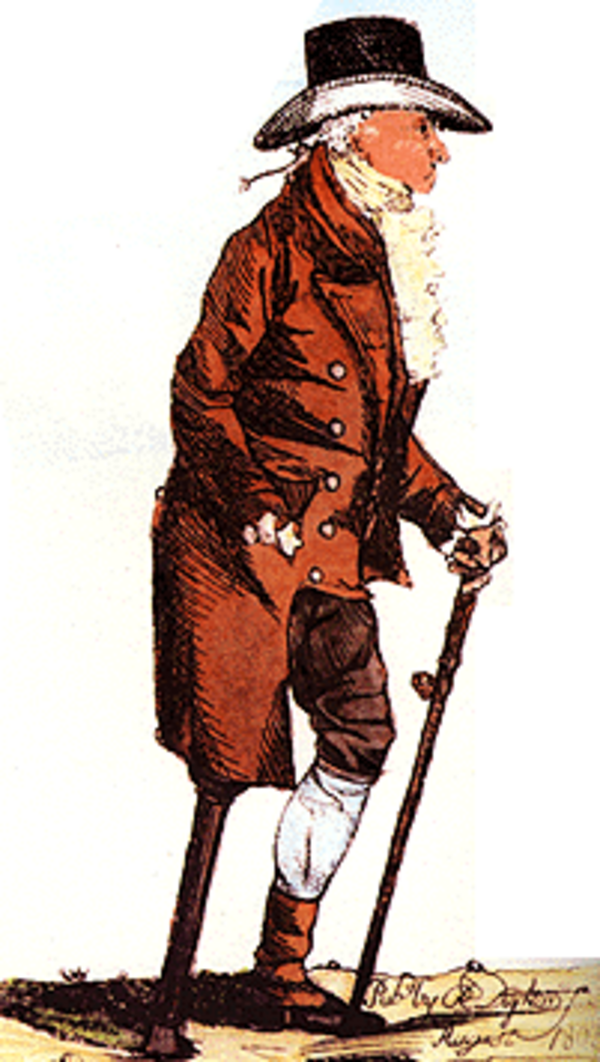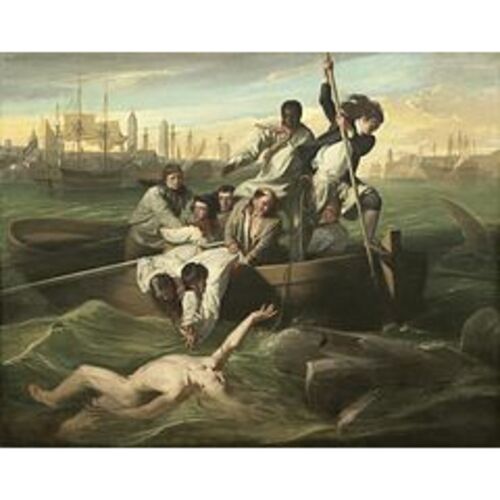
Source: Courtesy of Wikimedia Commons
WATSON, Sir BROOK, political merchant; b. 7 Feb. 1735/36 in Plymouth, England, son of John Watson and Sarah Schofield; d. 2 Oct. 1807 in East Sheen (London), England.
Orphaned at the age of six, Brook Watson was sent to a distant relative in Boston, Mass., and in 1750 was employed by Andrew Huston trading with the French and Indians in Nova Scotia. In 1752 Watson became secretary to Lieutenant-Colonel Robert Monckton* at Fort Lawrence (near Amherst, N.S.) and assisted Huston and Chief Commissary Joshua Winslow. Three years later he was sent to supervise the expulsion of the Acadians from the Baie Verte area. In 1758 he formed a business partnership with Joseph Slayter of Halifax, acting as agent for the Cumberland region. He moved to London the following year and in 1762 formed an association with John Lymburner, brother of Adam*, to enter the Quebec trade. From then on, Watson’s fortunes were founded on a series of partnerships. One of the most important was with Gregory Olive, the most durable with Robert Rashleigh; at one time all three men were in partnership. Their commercial interests concentrated on Nova Scotia and Quebec.
Watson’s involvement in both colonies became the greater as a result of his association with Joshua Mauger*. Mauger had established the basis of his wealth in Nova Scotia in the 1750s and maintained his interests there through a network of business associates that included Michael Francklin* and John Butler*. In developing his own interests in the colony Watson worked closely with the Mauger–Franklin group and lobbied in London on its behalf. Watson travelled to Quebec in 1766 and 1767 and made a good impression on Lieutenant Governor Guy Carleton; it was likely on one of these visits that he engaged George Allsopp as his principal business agent there. Around 1768 Mauger, who some years earlier had joined with a group of London merchants in a company to furnish supplies to the Quebec trade, brought Watson into the group and transferred his business to him. Watson’s commercial interests included trading fish from Labrador and Nova Scotia waters to Spain, and furs from Quebec to Britain; he engaged in the timber trade and the whale fishery and with Christophe Pélissier* and others he had a share of the Saint-Maurice ironworks. By the early 1770s he was the dominant figure in Nova Scotia’s commerce and he had also acquired considerable land holdings there. In 1775 he sent £32,000 worth of furs and £8,000 worth of other products from Quebec to his London warehouse; it was estimated that, but for the American invasion of Quebec that year [see Benedict Arnold; Richard Montgomery*], he could have shipped an extra £10,000 worth of goods.
Business interests of this magnitude naturally held political implications. In the 1770s Watson lobbied in London for the continuation of the timber bounty and in 1775 presented Lord Dartmouth with William Smith*’s plan for reorganizing the North American empire. In May that year he went to New York, where he talked in conciliatory tones to a number of future rebels while privately condemning the British government for its lack of firmness in the face of colonial resistance. With a laissez-passer from the Continental Congress he travelled to Crown Point (N.Y.) and on 10 July arrived in Quebec overland. After visiting Montreal, he sailed from Quebec on 11 November at the start of the siege, travelling on the Adamant together with Joseph Brant [Thayendanegea] and Indian Department officials Christian Daniel Claus* and Guy Johnson*. Within a year reports were circulating that Carleton was ordering defective goods for the Indian Department from Watson. The growing connection between the two men was demonstrated in 1778 when Carleton spoke to Chief Justice Peter Livius* in favour of Watson’s claim in a legal action involving Jean-Louis Besnard*, dit Carignant: Livius found against Watson’s side and was immediately dismissed from office.
When Sir Guy Carleton went to New York City as commander-in-chief in 1782, Watson accompanied him as commissary general. His principal responsibility was to oversee the evacuation of the loyalists to Nova Scotia, almost 30 years after he had helped expel the Acadians from the colony. Watson himself appreciated the irony of the situation. Despite the unpleasantness of the task he stood well with the loyalists. On his return to London he acted for many individuals claiming compensation for their losses and organized charitable subscriptions for the indigent. The new colony of New Brunswick appointed him agent in 1786, a post he held until 1794. Nova Scotia offered him the post of second agent, but he apparently declined; Lieutenant Governor Henry Hamilton* wrote from Quebec that he should be the agent for that province as well.
By the early 1780s Watson’s business house was carrying about one-quarter of Quebec’s trade. He was hard hit by the immediate post-war depression, when several of his correspondents failed. Merchants cast much of the blame on the “absurd Mixture of French & English Law,” which was the “Handle for Oppressive Partialities,” and on Governor Frederick Haldimand for countenancing them. Watson told the House of Commons – he had been elected for the City of London in 1784 – that the Quebec Act of 1774 had set up “a weak and inadequate system of government” and he wished to see English law, especially in commercial matters, introduced. He had strong ties with the English party in Quebec through such men as Lieutenant Governor Hamilton, Attorney General James Monk*, and councillors William Grant (1744–1805) and Thomas Dunn. He was convinced that his upright friend Sir Guy Carleton should return to Quebec as governor.
Between 1784 and 1786 Watson acted as Carleton’s chief advocate with the British government. He was able to use his position as an mp and as a distant relative by marriage of William Pitt to compensate for Carleton’s own lack of family connections and diffidence about pushing himself forward. Whenever Carleton came to London he visited Watson, and the visits increased as the negotiations intensified. Both men received parliamentary pensions in their wives’ names on the same day in June 1786. When Carleton, who had obtained a peerage from a reluctant administration, returned to Quebec, he took two of Watson’s men with him: Thomas Aston Coffin as civil secretary and William Smith as chief justice. Smith repaid Watson’s confidence in him by his first decision from the bench: the Quebec Act, he ruled, had not taken English law away from Englishmen.
From 1793 to 1796 Watson acted as commissary general to the army in Flanders and from 1798 to 1806 as commissary general of Great Britain. In the later years of his life he also served as chairman of Lloyd’s of London and deputy governor of the Bank of England. One of his principal claims to fame among his contemporaries was that he became, in 1796, the first one-legged lord mayor of London. At the age of 14 he had lost a leg to a shark in Havana harbour. In 1778 he commissioned John Singleton Copley to depict the scene in a painting that quickly became a popular mezzotint. When he received his baronetcy on 5 Dec. 1803, Watson’s new coat of arms featured “a human Leg crest and erased below the Knee” as well as Neptune “repelling a Shark in the Act of securing its Prey.”
Watson had married, in 1760, Helen, daughter of Colin Campbell, goldsmith of Edinburgh, Scotland. There were no surviving children. A great-nephew inherited the baronetcy.
[Sir Brook Watson bequeathed the painting by John Singleton Copley, Watson and the shark (1778), to Christ’s Hospital, then situated in London, since it “holds out a useful lesson” for youth. The painting is now in the National Gallery of Art (Washington). A second version by Copley (1778) is in the Boston Museum of Fine Arts, and the Beaverbrook Art Gallery (Fredericton) has a miniature. An engraving of the original painting, by Valentine Green (1779), is in N.B. Museum, Webster coll. of Canadiana, no.1792, as is a cruder, undated French engraving, which prints the scene in reverse.
In 1788 James Bretherton made an etching of Watson addressing the House of Commons, and Robert Dighton published a coloured caricature of him in 1803; copies of both are in N.B. Museum, Webster coll. of Canadiana, nos. 1794, 1795. The same collection has an undated portrait by Copley of Watson in robes that have been erroneously described as those of lord mayor but are perhaps those of sheriff (no.1791); another version is in the Indianapolis Museum of Art. The Webster collection also has an oil painting by a Mr Callender (1805), Brook Watson and cattle incident at Chignecto in April, 1755 (no.1797). The Church of St Mary the Virgin in Mortlake (London), where Watson lies buried, also has an engraving of him.
No family or business papers have survived. Watson’s papers as commissary general in America are in PRO, WO 60/12–15; in Flanders, WO 1/166–73; and of Great Britain, WO 58/1–57. l.f.s.u.]
ASQ, Fonds Viger–Verreau, Carton 37, no.238. BL, Add. mss 19071: ff. 249–50. NYPL, Philip Schuyler papers, no.1522, Gen. Richard Montgomery to Schuyler, 13 Nov. 1775. PANS, A. J. H. Richardson, “Sir Brook Watson” (mfm.); MG 1, 936B (transcript). PRO, PROB 11/1470/ 930. G.B., Hist. mss Commission, The manuscripts of the Earl of Dartmouth (3v., London, 1887–96), 2: 82–83, 262. N.S. , House of Assembly, Journal and proc., 1784:96. The parliamentary history of England from the earliest period to the year 1803, comp. William Cobbett and John Wright (36v., London, 1806–20), 27: 524. Proceedings in the case of Peter Livius ([London, 1790]), 37. Smith, Diary and selected papers (Upton), 1: 217–18; 2: 56, 94. Quebec Gazette, 13 July, 16 Nov. 1775. DNB. “State papers,” PAC Report, 1890: 79. C. A. M. Edwards, Brook Watson of Beauséjour (Toronto, 1957). J. C. Webster, “Sir Brook Watson: friend of the loyalists, first agent of New Brunswick in London,” Argosy (Sackville, N.B.), 3 (1924–25): 3–25.
Cite This Article
L. F. S. Upton, “WATSON, Sir BROOK,” in Dictionary of Canadian Biography, vol. 5, University of Toronto/Université Laval, 2003–, accessed April 21, 2025, https://www.biographi.ca/en/bio/watson_brook_5E.html.
The citation above shows the format for footnotes and endnotes according to the Chicago manual of style (16th edition). Information to be used in other citation formats:
| Permalink: | https://www.biographi.ca/en/bio/watson_brook_5E.html |
| Author of Article: | L. F. S. Upton |
| Title of Article: | WATSON, Sir BROOK |
| Publication Name: | Dictionary of Canadian Biography, vol. 5 |
| Publisher: | University of Toronto/Université Laval |
| Year of revision: | 1983 |
| Access Date: | April 21, 2025 |




